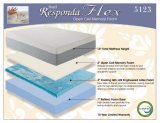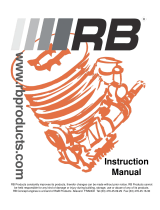
18
•
T-MAXX 3.3 OWNERS MANUAL
The TRX 3.3 Racing Engine uses a ringless, aluminum-
brass-chrome (ABC) piston/sleeve construction. This
type of engine design relies on a very precise running fit between the
piston and sleeve for cylinder sealing. Engine break-in is necessary to
allow the piston and sleeve to develop an extremely precise fit and
optimum cylinder sealing. Therefore, proper engine break-in is critical to
achieving the fastest, most reliable engine performance.
Allow yourself about 1 to 1
1
/
2
hours to complete the break-in procedure. The
engine break-in period will take 5 tanks of fuel in a T-Maxx 3.3. The break-in
time is not the time to impress your friends with your new T-Maxx 3.3. You
must wait until the engine is fully broken in before attempting sustained
high speed running. Patience and careful attention during break-in will
reward you with the best-performing TRX 3.3 Racing Engine possible.
During break-in, your engine may appear to malfunction with symptoms
like stalling, inconsistent performance, and fouled glow plugs. These are
simply the normal “break-in pains” engines sometimes go through. They
will disappear once your engine is fully broken in. Many owners report
not experiencing any of these symptoms with TRX Racing Engines. We
recommend to go ahead and replace the glow plug with a new one
(included) after the engine break in procedure.
Engine Break-in Procedure
The focus during break-in is to vary and limit the engine speed. This will
be accomplished by accelerating and stopping at different rates for the first
5 tanks of fuel. As the engine begins to break-in, the duration and intensity
of the acceleration will gradually increase. Sustained high-speed running
is not permitted until the 6th tank of fuel. Perform the initial break-in on a
large, flat, paved surface. T-Maxx 3.3 is very fast and by tanks 4 and 5 you
will need plenty of room for the truck to run in. Apply all throttle and
braking actions gently. Abrupt acceleration or braking could cause the
engine to stall unnecessarily.
• Special break-in fuels are not recommended. Use the same fuel you plan
to use everyday.
• If possible, avoid breaking-in the engine on extremely hot or cold days
(see page 19).
• Pay careful attention to the fuel level. Do not allow the fuel tank to run
completely empty. An extremely low fuel level causes the mixture to
run too lean. This could result in a burned glow plug or extremely high
engine temperatures.
• Do not attempt to break in the TRX 3.3 Racing Engine by idling it on a
stand. This will produce poor results.
• Keep extra Traxxas glow plugs handy. The break-in process can cause
deposits to form on the plug leading to plug failure.
• Change or clean your air filter after break-in.
• Follow the instructions exactly for each of the first 5 tanks of fuel.
• Never run your T-Maxx 3.3 indoors. Since the TRX 3.3 Racing Engine
exhaust fumes are harmful, always run your model outdoors, in a well-
ventilated area.
Starting Your TRX 3.3 Racing Engine for the First Time
Before you start your TRX 3.3 Racing Engine for the first time, make sure
you have read all instructions and precautions in this manual. Pay close
attention to the tank-by-tank break-in instructions in the next section,
and make sure you have read and understood them before you run
your engine.
Your engine must be at room temperature (70°F or 21° C) or above the
first time you start it. If it’s cooler than room temperature outside, remove
all fuel and keep your T-Maxx 3.3 indoors until you’re ready to start it and
then take it outside. If it’s colder than 45 degrees, special considerations
should be made. See cold weather break-in on page 19. We do not
recommend running the model in temperatures below 35 degrees.
1. Turn on the radio system (see page 9).
2. Make sure the throttle trigger on the
transmitter is in the idle (neutral) position.
3. Connect the EZ-Start controller according to
the instructions on page 17.
4. Press the starter button in short two second
bursts and watch for fuel moving through the
fuel line up to the carburetor. Watch closely!
The fuel moves very fast. If the fuel doesn’t
move through the line within 5 seconds, prime the engine by briefly
(one or two seconds) covering the exhaust outlet with your finger until
the fuel is just visible in the carburetor fuel line. Watch carefully! If the
engine is primed too long, it will flood with fuel and stop turning.
5. Once fuel reaches the carburetor, the engine should
quickly start and idle.
6. Disconnect the EZ-Start controller from the model.
7. Proceed with the engine break-in.
8. Do not rev your engine with no load (wheels off the ground).
If your engine doesn’t start, refer to the troubleshooting tips beginning
on page 28 or go online to www.traxxas.com/support. If your factory
fuel mixture settings have been altered, refer to page 16. If you still
have problems, contact Traxxas Customer Support at 1-888-TRAXXAS or
Break-in Checklist
Note: The wheelie bar is installed in the “down” position to help keep the
front of the T-Maxx 3.3 down during acceleration. Apply throttle gradually to
prevent wheelies during break-in. See page 26 for wheelie bar adjustment.
Tank 1
1. Drive the model with the body off.
2. Driving procedure: Gently pull the throttle trigger to 1/4 throttle
over a 2-second count. Then gently apply the brake to stop. Count
the two seconds out while accelerating: one thousand one, one
thousand two, and then stop. Operate the throttle trigger as smoothly
as you can. Repeat this starting and stopping procedure until the
first tank of fuel is nearly empty.
3.
Look for thick blue smoke exiting the exhaust outlet. If there is
no smoke, richen the high-speed needle 1/4 turn, by turning the
needle counterclockwise.
4. When the fuel tank is nearly empty, shut off the engine by pinching
the fuel line connected to the carburetor (use the installed clamp).
5. Let the engine cool for 15 minutes.
Note: If at any point the engine cuts out or stalls during gentle
acceleration, richen the high-speed needle 1/4 turn by turning the
needle counterclockwise.
BREAKING IN YOUR TRX 3.3 RACING ENGINE
THE TRX 3.3 RACING ENGINE
As you gain experience in the hobby, you may discover that many
people have differing opinions on what is the proper procedure to
break-in a model engine. Only use the Traxxas break-in procedure.
Other break-in procedures could result in a weak, damaged, or
otherwise poor performing engine. The procedure outlined here was
extensively tested and proven to yield better performing engines
than other “common” break-in methods. Even if you have years of
experience using model engines, please do not ignore this caution!
Your TRX 3.3 Racing Engine doesn’t usually require priming. If you
do need to prime your engine, watch the fuel line carefully to avoid
ooding your engine. See page 29 for information on clearing a
ooded engine
See Important Points to Remember on page 3 for other precautions.























